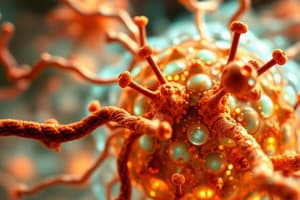Podcast
Questions and Answers
What is the primary function of receptors on the plasma membrane?
What is the primary function of receptors on the plasma membrane?
- To generate energy for the cell
- To specifically bind to certain substances (correct)
- To synthesize proteins for export
- To regulate cell division
Where are the receptors located that are involved in chemical transmission?
Where are the receptors located that are involved in chemical transmission?
- Plasma membrane (correct)
- Mitochondria
- Nucleus
- Endoplasmic reticulum
What is the source of ligands to which the receptors bind?
What is the source of ligands to which the receptors bind?
- Lysosomes
- Ribosomes
- Soluble ligands (correct)
- Golgi apparatus
Activation of cell membrane receptors can lead to which of the following intracellular changes?
Activation of cell membrane receptors can lead to which of the following intracellular changes?
What type of signaling involves cells responding to signals they themselves produce?
What type of signaling involves cells responding to signals they themselves produce?
What process can be initiated by signals transmitted from cell membrane receptors?
What process can be initiated by signals transmitted from cell membrane receptors?
Which type of signaling uses hormones transported through the bloodstream?
Which type of signaling uses hormones transported through the bloodstream?
Which type of signaling involves the release of neurotransmitters across a narrow space?
Which type of signaling involves the release of neurotransmitters across a narrow space?
What is the main characteristic of paracrine signaling?
What is the main characteristic of paracrine signaling?
In synaptic signaling, where are neurotransmitters released?
In synaptic signaling, where are neurotransmitters released?
What facilitates direct cytoplasmic communication between plant cells?
What facilitates direct cytoplasmic communication between plant cells?
What type of signaling involves cells stimulating themselves?
What type of signaling involves cells stimulating themselves?
Which structure permits chemical, mechanical, and electrical coupling between neighboring animal cells?
Which structure permits chemical, mechanical, and electrical coupling between neighboring animal cells?
What relies on local mediators, as seen in inflammation?
What relies on local mediators, as seen in inflammation?
What describes informative secreted molecules released by secretory cells that act on distant target cells?
What describes informative secreted molecules released by secretory cells that act on distant target cells?
What primarily differentiates paracrine, synaptic, and endocrine signaling?
What primarily differentiates paracrine, synaptic, and endocrine signaling?
Adrenaline can function as which of the following?
Adrenaline can function as which of the following?
How does the delivery of signaling molecules occur in plants, considering their unique structure?
How does the delivery of signaling molecules occur in plants, considering their unique structure?
What are signaling molecules in plants called?
What are signaling molecules in plants called?
Compared to animals, phytohormones are generally:
Compared to animals, phytohormones are generally:
What type of molecule are water-soluble signaling molecules primarily?
What type of molecule are water-soluble signaling molecules primarily?
What is required for water-soluble signaling molecules to transmit signals inside target cells?
What is required for water-soluble signaling molecules to transmit signals inside target cells?
Which of the following is an example of a neurotransmitter that is an amino acid derivative?
Which of the following is an example of a neurotransmitter that is an amino acid derivative?
Which of the following is a glycoprotein hormone?
Which of the following is a glycoprotein hormone?
Which of the following is a liposoluble signaling molecule?
Which of the following is a liposoluble signaling molecule?
What kind of protein are membrane receptors typically classified as?
What kind of protein are membrane receptors typically classified as?
Which of the following is an example of a glycoprotein hormone?
Which of the following is an example of a glycoprotein hormone?
What is the immediate result of a ligand binding to a membrane receptor?
What is the immediate result of a ligand binding to a membrane receptor?
What is one potential outcome of receptor activation?
What is one potential outcome of receptor activation?
What is a characteristic of liposoluble signaling molecules?
What is a characteristic of liposoluble signaling molecules?
How do liposoluble signaling molecules typically enter target cells?
How do liposoluble signaling molecules typically enter target cells?
What is one of the possible effects of activating membrane receptors on cellular processes?
What is one of the possible effects of activating membrane receptors on cellular processes?
Which process is commonly regulated by liposoluble signaling molecules in target cells?
Which process is commonly regulated by liposoluble signaling molecules in target cells?
What change in RNA synthesis can be caused by receptor activation?
What change in RNA synthesis can be caused by receptor activation?
What is a typical duration of effect for water-soluble signaling molecules?
What is a typical duration of effect for water-soluble signaling molecules?
What is the function of an antagonist molecule in cell signaling?
What is the function of an antagonist molecule in cell signaling?
What is the main function of agonist molecules?
What is the main function of agonist molecules?
Which of the following is an example of an agonist?
Which of the following is an example of an agonist?
What is a therapeutic application of identifying signaling molecule antagonists?
What is a therapeutic application of identifying signaling molecule antagonists?
What is the mechanism used by membrane receptors for chemical signals?
What is the mechanism used by membrane receptors for chemical signals?
What is a key characteristic of G-protein-coupled receptors (GPCRs)?
What is a key characteristic of G-protein-coupled receptors (GPCRs)?
Which of the following molecules is known to bind to GPCRs?
Which of the following molecules is known to bind to GPCRs?
What is the role of fatty acids in the context of G proteins?
What is the role of fatty acids in the context of G proteins?
How does information transfer occur between the membrane receptor and primary effectors in GPCR signaling?
How does information transfer occur between the membrane receptor and primary effectors in GPCR signaling?
Which of the following is a function that GPCRs are involved in regulating?
Which of the following is a function that GPCRs are involved in regulating?
What is a key characteristic of the interaction between a ligand and its receptor?
What is a key characteristic of the interaction between a ligand and its receptor?
What is the typical range for the number of receptors found in a target cell?
What is the typical range for the number of receptors found in a target cell?
How does an agonist affect a receptor?
How does an agonist affect a receptor?
What is the function of an antagonist in relation to a receptor?
What is the function of an antagonist in relation to a receptor?
What is the direct result of ligand-induced receptor activation?
What is the direct result of ligand-induced receptor activation?
Flashcards
Plasma Membrane Receptors
Plasma Membrane Receptors
Receptors on the plasma membrane specifically bind to soluble ligands, extracellular matrix, and components on the surface of other cells.
Signal Transduction
Signal Transduction
Stimulation of cell surface receptors can be converted to intracellular signals.
Enzyme Activation
Enzyme Activation
Intracellular signals can activate specific enzymes.
Cytoskeleton and Permeability Changes
Cytoskeleton and Permeability Changes
Signup and view all the flashcards
DNA Synthesis & Gene Expression
DNA Synthesis & Gene Expression
Signup and view all the flashcards
Gap Junctions
Gap Junctions
Signup and view all the flashcards
Cell Adhesion Molecules (CAMs)
Cell Adhesion Molecules (CAMs)
Signup and view all the flashcards
Chemical Signals
Chemical Signals
Signup and view all the flashcards
Plasmodesmata
Plasmodesmata
Signup and view all the flashcards
Paracrine Signaling
Paracrine Signaling
Signup and view all the flashcards
Autocrine Signaling
Autocrine Signaling
Signup and view all the flashcards
Synaptic Signaling
Synaptic Signaling
Signup and view all the flashcards
Endocrine Signaling
Endocrine Signaling
Signup and view all the flashcards
Intercellular Communication
Intercellular Communication
Signup and view all the flashcards
Phytohormones
Phytohormones
Signup and view all the flashcards
Pleiotropic Effects of Phytohormones
Pleiotropic Effects of Phytohormones
Signup and view all the flashcards
Water-Soluble Signaling Molecules
Water-Soluble Signaling Molecules
Signup and view all the flashcards
Local Chemical Mediators
Local Chemical Mediators
Signup and view all the flashcards
Neurotransmitters
Neurotransmitters
Signup and view all the flashcards
Glycoprotein/Protein Hormones
Glycoprotein/Protein Hormones
Signup and view all the flashcards
Liposoluble Signaling Molecules
Liposoluble Signaling Molecules
Signup and view all the flashcards
Glycoprotein and Protein Hormones
Glycoprotein and Protein Hormones
Signup and view all the flashcards
Liposoluble Signals Characteristics
Liposoluble Signals Characteristics
Signup and view all the flashcards
Water-Soluble Signals Characteristics
Water-Soluble Signals Characteristics
Signup and view all the flashcards
Membrane Receptors
Membrane Receptors
Signup and view all the flashcards
Receptor Activation
Receptor Activation
Signup and view all the flashcards
Agonist
Agonist
Signup and view all the flashcards
Antagonist
Antagonist
Signup and view all the flashcards
Results of Receptor Activation
Results of Receptor Activation
Signup and view all the flashcards
Signaling Molecule
Signaling Molecule
Signup and view all the flashcards
Allosteric Receptors
Allosteric Receptors
Signup and view all the flashcards
Therapeutic Applications
Therapeutic Applications
Signup and view all the flashcards
GPCRs
GPCRs
Signup and view all the flashcards
GPCR Ligands
GPCR Ligands
Signup and view all the flashcards
G Protein Function
G Protein Function
Signup and view all the flashcards
Ligand-induced Amplification
Ligand-induced Amplification
Signup and view all the flashcards
G Protein Subunits
G Protein Subunits
Signup and view all the flashcards
G Protein Location
G Protein Location
Signup and view all the flashcards
High Affinity Interaction
High Affinity Interaction
Signup and view all the flashcards
Receptor Quantity
Receptor Quantity
Signup and view all the flashcards




